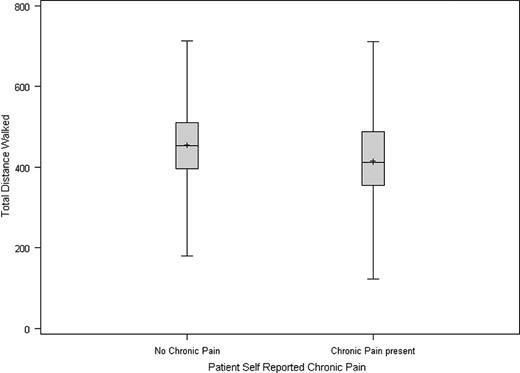Abstract
Abstract 2658
Six minute walk distance (6MWD), is a measure of exercise capacity commonly used as an endpoint in pulmonary hypertension (PH) clinical trials. Many patients with sickle cell disease (SCD) have acute pain crises or chronic pain syndromes that impair their quality of life. While patients with SCD who are undergoing screening for PH are generally screened in steady state, i.e., when they have not had a recent pain crisis, the impact of chronic pain on exercise capacity in this group of patients has not been previously evaluated.
walk-PHaSST was a multi-center screening study designed to identify subjects with SCD at increased risk for symptomatic PH, defined by a tricuspid regurgitant velocity (TRV) ≥ 2.7 m/sec and 6MWD between 150–500 meters, for enrollment in a double-blind placebo controlled trial of sildenafil. The primary endpoint was the change in 6MWD after 16 weeks of treatment. We examined the relationship between subjects' self-reported acute and chronic pain and baseline 6MWD in the screened SCD patients in walk-PHaSST.
For 90% of subjects, the information about pain was reported by the patient or parent/family member. Documentation of pain management and utilization of services was verified from medical records in 10% of subjects. Ninety four percent of all subjects reported having a history of acute sickle cell pain crises; 6% reported never having had an acute pain crisis. For the subjects who reported a history of acute pain crises, the ‘typical’ acute pain rating on a scale of 0 to 10 was ≥ 7 (maximum 10) for 77% of this subset of subjects. A total of 342 (50%) subjects reported not having had any pain crises in the preceding week. Of 720 subjects screened medical history and 6 MWD was available in 673 patients. Of these 633 (94%) subjects did not report having had a pain crisis requiring an emergency department visit or hospitalization in the preceding week. A total of 39% of subjects reported chronic sickle cell related pain; no rating was reported for chronic pain. 88% of patients reported using medications for pain control while 15% reported using non-drug therapy including physical therapy in 3%, alternative therapy in 2%, acupuncture in 2% and hypnosis in < 1% of patients. The mean 6MWD for the screened population was 439 meters (median 438 m, range 123–713 m). A total of 171/673 (26%) subjects had a 6MWD >500 meters, which was above the screening cut-off for enrollment in the main interventional trial. By univariate analysis, subjects reporting chronic pain had a significant lower odds ratio for walking > 500 meters (OR 0.637, 95% C.I 0.44–0.99); a similar observation was seen with those subjects with a history of acute pain crises (OR 0.47, 95% C.I 0.24–0.91). Multivariable logistic regression analysis revealed a significant inverse relationship between chronic pain but not acute pain and 6MWD after adjusting for age, TRV, gender, hematocrit and smoking history (See Table 1). The mean 6MWD decreased by 27 meters with self reported chronic pain after adjusting for TRV, age, gender, hematocrit and 6MWD.
TRV is a known predictor of 6MWD. However, these data suggest that patient self reported sickle cell related chronic pain is also an independent predictor of 6MWD. This relationship raises interesting questions about the potentially confounding effects of pain on exercise capacity as assessed by the 6MW test. Further study is warranted to investigate an association between chronic pain and exercise capacity in SCD as well as exploration of appropriate endpoints for future clinical trials in patients with SCD and suspected symptomatic PH.
Odds Ratio estimates: Multivariable Analysis
| Parameter . | Estimate . | Standard Error . | Wald 95% Confidence Limits . | p-value . | |
|---|---|---|---|---|---|
| Chronic Pain | −27.2 | 8.0 | −42.9 | −11.6 | 0.0007 |
| TR Jet Velocity | −30.6 | 9.9 | −49.9 | −11.1 | 0.0020 |
| Age | −0.9 | 0.3 | −1.5 | −0.3 | 0.0022 |
| Sex | −39.1 | 7.6 | −53.9 | −24.3 | <.0001 |
| Parameter . | Estimate . | Standard Error . | Wald 95% Confidence Limits . | p-value . | |
|---|---|---|---|---|---|
| Chronic Pain | −27.2 | 8.0 | −42.9 | −11.6 | 0.0007 |
| TR Jet Velocity | −30.6 | 9.9 | −49.9 | −11.1 | 0.0020 |
| Age | −0.9 | 0.3 | −1.5 | −0.3 | 0.0022 |
| Sex | −39.1 | 7.6 | −53.9 | −24.3 | <.0001 |
Relationship between chronic pain and six minute walk distance
Relationship between chronic pain and six minute walk distance
Barst:Pfizer: Consultancy, Research Funding. Rosenzweig:Pfizer: Research Funding. Badesch:Pfizer: Honoraria, Research Funding. Hassell:Novartis: Research Funding.
Author notes
Asterisk with author names denotes non-ASH members.


This feature is available to Subscribers Only
Sign In or Create an Account Close Modal